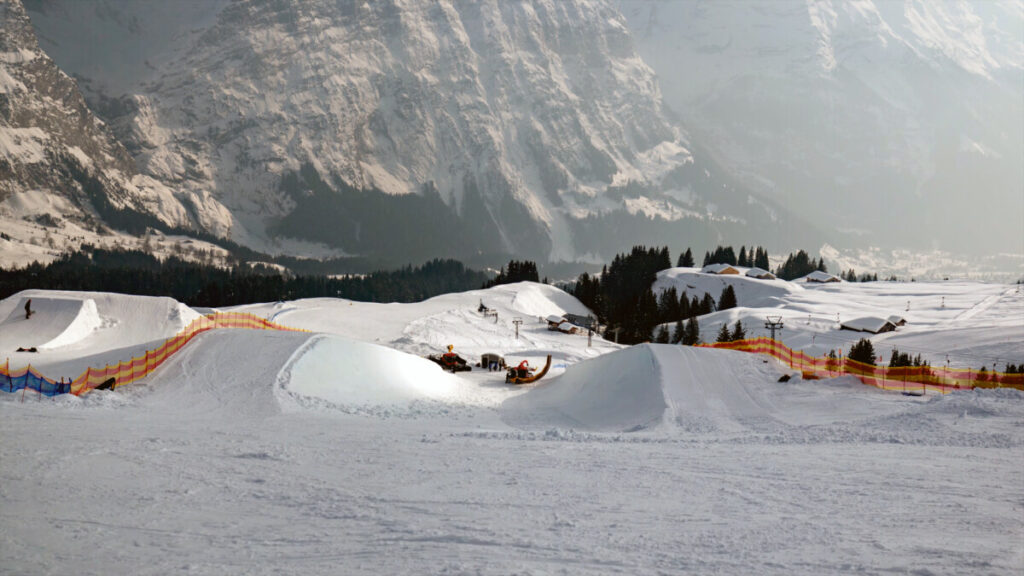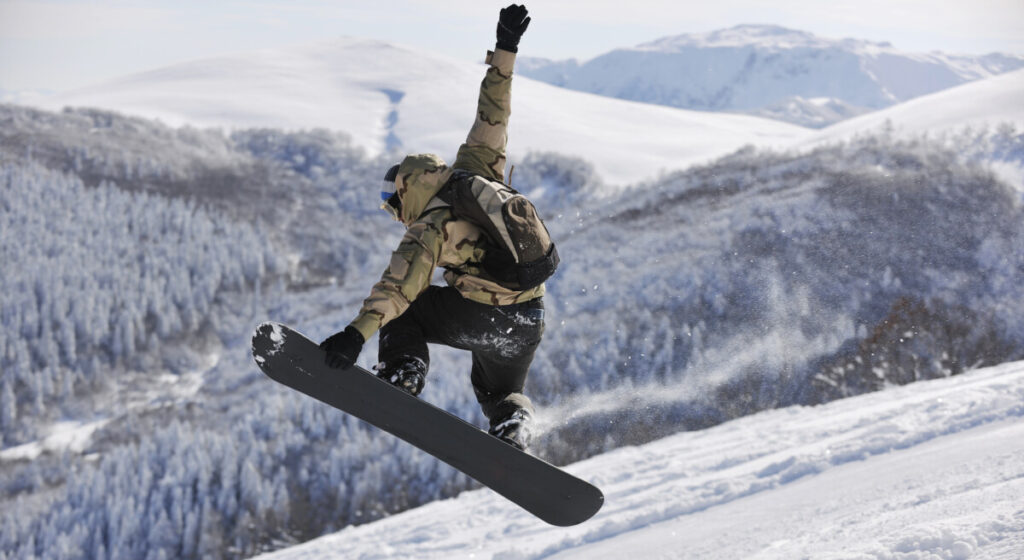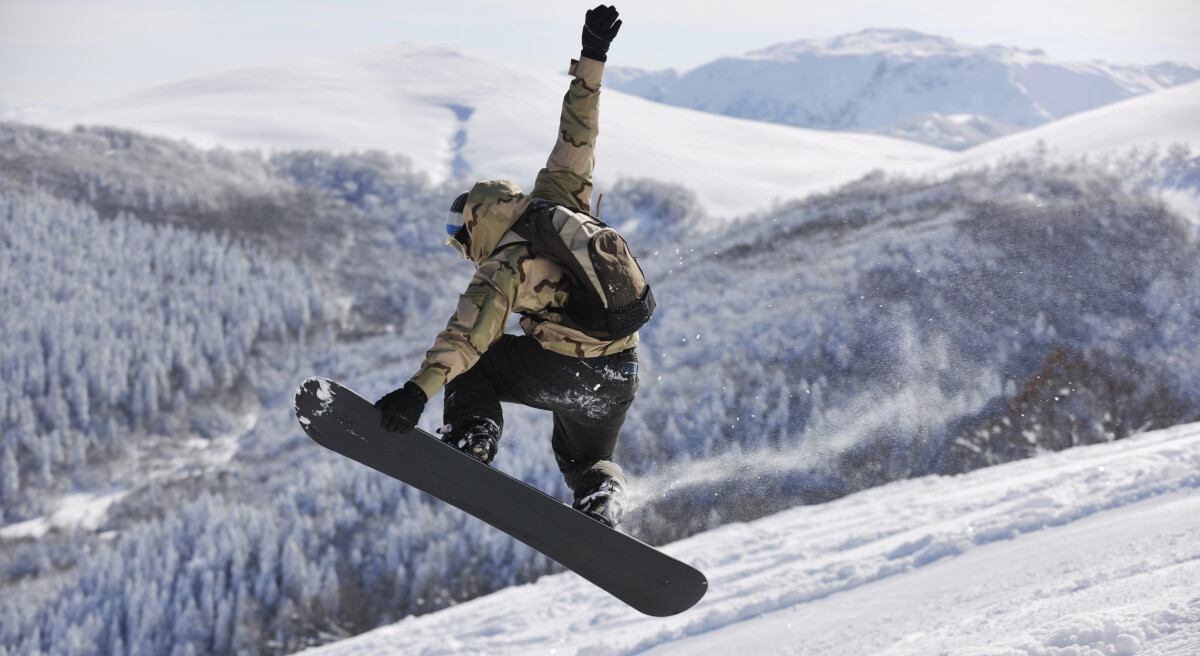The snowboarding half-pipe event is a relatively newer winter sport than most people realize. It had its first worldwide championship in 1983 at Soda Springs, California. X Games. The Winter Olympics eventually followed suit in 1997 and 1998, respectively. Since snowboarding’s inception, these major international multi-sport events have improved the winter sport, making it more appealing, exciting, and safer. There are many aspects of the sport that have changed over the past few decades and that have contributed to making it the rapidly expanding sport that it is today.

Physical Changes to the Half-Pipe
One of the many developments we have seen in the half-pipe is the physical alteration of the half-pipe itself. It started with changing the dimensions. Compared to today, half-pipes were significantly smaller when the sport was first founded by Tom Sims in Soda Springs, California in 1983. This was in large part because there was no direct heavy machinery made for this particular event when it first appeared. Instead, half-pipes were hand-cut. Then in 1990, a huge technological advancement was made. The length, width, height, transition radius, and wall angle of the old half-pipe would range from 150-300 feet, 50-100 feet, 8-20 feet, 15-30 feet, and 70-90 degrees respectively. Eventually in 1990, an engineer named Doug Waugh created what is known as the Pipe Dragon. This mechanism is a grooming machine that has a curved arm attached to an excavator with tracks. The hydraulic rotating blades in the Dragon’s arm can cut one 10-to-12-foot wall at a time, and it can make multiple passes to create a uniform pipe more easily and cheaply than pervious methods. This invention spurred the growth of halfpipes among ski resorts. Unlike the old half-pipe, new half-pipes have a length, width, height, transition radius, and wall angle that range from 300-600 feet, 50-80 feet, 12-22 feet, 18-30 feet, and 85-90 degrees respectively. All these dimensions vary depending on the sporting event or if it is used for recreational purposes. The most notable change by far is the length, as it has doubled in size. The other changes in the dimensions are relatively insignificant, as there were small increases or decreases. One thing that remained constant from the old half-pipes to the new half-pipes is the coping. It is the same, as they all have either a metal or PVC coping that extends a few inches above the deck, enabling snowboarders to perform all types of tricks. What prompted the change to a new halfpipe was that snowboarders kept pushing for more air. With the constant progression that we have seen from these performers, the halfpipe is very much subject to change in the near future.
Snowboarders’ Improvements in Tricks and Techniques
Another area in which snowboarding half-pipe events have improved has been the creativity of the tricks and techniques. The moves that are performed on a consistent basis today seemed inconceivable back then. Sitting on the couch and watching Chloe Kim perform back-to-back 1080s was not the norm during the early phases of the halfpipe event for both men and women. Shaun White, one of the most prolific snowboarders of the sport, was known for the stunts he pulled off during international competitions. But even the greatest of all time had a historic halfpipe progression.
In the Winter Olympics of Torino in 2006, White’s trick list consisted of a McTwist, Frontside 1080, Fakie 1080, Frontside 900, and Backside 900. At the time, the difficult tricks that White needed to execute in order to be on the podium were the 1080s. The Winter Olympics in 2010 at Vancouver proved to be a watershed for not just White and his professional career, but for the sport as well. The 2010 event was the first time White attempted and landed a double McTwist 1260, which was groundbreaking at the time. His trick list during this event included the notorious Double McTwist 1260. The Double McTwist 1260, in particular, was a revolutionary trick. It involves two flips and 3.5 spins while inverted, making it one of the most complex and high-risk maneuvers in snowboarding. Shaun White’s willingness to attempt and then land this trick successfully in competition demonstrated his commitment to innovation and his willingness to take risks to win. In Sochi of 2014, White was able to land a Cab double cork 1440, which is when a rider approaches a jump or halfpipe backward and executes two horizontal flips while spinning four full rotations (1440 degrees). This was the first time he executed a Cab double cork 1440, which shows his steady improvement since Vancouver. In PyeongChang 2018, White went deep into his bag of tricks. He performed a jaw-dropping Frontside double cork 1440, Cab double cork 1440, Frontside 540, Double McTwist 1260, and Frontside 1260. He added to his already legendary career by securing his third Olympic gold medal.
Comparing all his Olympic runs puts the development of the sport into perspective. Not only do we see an upward trend of moves and tricks in the men’s halfpipe, but also the women’s halfpipe has become far more exciting. More spins and more flips are being added to the wide array of tricks that the snowboarders possess. The women’s halfpipe debuted at the 1998 Winter Olympics in Nagano, Japan. At the time, the halfpipe was remarkably smaller (half the size) than the men’s standard twenty-two-foot walls since 2010. This key difference limited the women athletes on the variety of moves that would be feasible to attempt. Because of this constraint, the competitors chose to emphasize their style, direction, and board grabs instead of rotations and height. The gold medal winner, Nicole Thost, exhibited a Frontside alley-oop and a Backside 540. Though it may seem underwhelming to win a gold medal by today’s standards, it was impressive in 1998. In 2002 at Salt Lake City, gold medalist Kelly Clark displayed the progression of the halfpipe event. She pulled off a McTwist and Frontside 720. Her inclusion of a McTwist was a significant moment in the sport’s history, as it was a complex and challenging maneuver that had not been commonly seen in women’s half-pipe competition. Clark helped push the boundaries and inspire other female riders to try more advanced tricks. Athletes were able to perform far more moves because of the physical changes to the halfpipe. In 2018 at PyeongChang, the-young-up and comer Chloe Kim was able to show the true evolution of the halfpipe event by displaying a Frontside 1080 and Cab 1080. Both of these moves are highly technical and of the upmost difficulty. They require mastery of the half-pipe and courage. Like Kelly Clark, the inclusion of these two moves were rarely seen in women’s half-pipe. Just as White dedicated years to honing his skills, each female gold medalist displayed gradual improvement in her performance. In 1999, Deseret News detailed the difficult Category III maneuvers, which include a 720-degree front-side spin and an inverted 180-degree flip. In both the men’s and women’s halfpipe at the Olympics, it is extraordinary to see how 540s and 720s would not pull the same weight as they once did. Moves that are frequently spotted now are switch riding (non-dominant foot forward), triple corks, technical grabs, combo tricks, inverted rodeo tricks. The expectations continue to rise for these athletes, as the audience demands a new alien-like maneuver to be unleashed during each Olympic game.

Halfpipe Scoring System
With the development of new and improved tricks and techniques, the way that each move was scored evolved. Apart from the direct correlation between new moves and scoring, other factors that contributed to the change of the scoring system were subjectivity, consistency, aligning with international standards, improvements in technology, and overall fairness. Until the 2014 Winter Olympics in Sochi, the highest score you could receive on a run was fifty which is half of the highest maximum score you can receive today. Judges tallied this score by subdividing the total score into five different categories: standard airs, rotations, amplitude, landings, and technical merit. Each subcategory held equal weight, as it accounted for 20% of the athlete’s total score. This meant that the highest possible number of points one could receive in each subcategory was 10, making the perfect score of 50. After the Sochi Winter Olympics, a more systematic approach was implemented to score each of the contestant’s runs more accurately. Now, when contestants finish a run, they receive a score determined by a panel of six judges ranging from 0 -100 (0 being the worst and 100 being perfect, though no one has ever received an actual score of 0). Each of the six judges individually comes up with a score he or she feels best reflects the run, which typically varies from judge to judge. All the scattered numbers and subjective scores called for a better method for competitions. Instead of finding the cumulative score of the six grades or average of the six numbers as in 2010, the judges now disregard the highest and lowest score given and then proceed to take the average of the remaining four scores. That number is the score the athlete receives on a single run. As with the previous system, these numbers are determined by a myriad of factors including amplitude, difficulty, variety, utilization of the full pipe, and consecutive combinations of tricks. This is the halfpipe scoring system that we see today in the Winter Olympics.
The Future
We have seen the snowboarding halfpipe evolve in a way that has increased its appeal for performers, audience members, and media. We have seen changes in the design of the halfpipe, which allowed athletes to unlock new moves, ultimately leading to a change in the scoring system. It has proven to be a progressive sport, meaning that it is safe to say that we will probably never see a final stage. Athletes will continue to advance their game, given their devotion to entertain themselves and their fans. As for judging, there have been demands to improve the scoring system drastically. There have been numerous complaints and an abundance of criticism concerning the 2022 Winter Olympics in Beijing. These remarks called out judges for their blatant errors and inconsistent scoring. Judges Carter Smith, Fredrik Westman, Julien Haricot, Jonas Brewer, Ryo Hashimoto, and Markus Betschart claimed that they were not provided with the right camera angles to make the best calls. Snowboarder Ayumo Hirano is discouraged about the outlook of judging at future events. He believes judges need to be given the right video displays, and proper training and accountability. A fully-automated judging technology has been developed by Canon and is currently being tested for practical usage. Although judges like Bertrand Dénervaud are in favor of the added consultation to the next Winter Olympics, they are hesitant to accept this practice fully, as it may jeopardize their jobs. They are afraid of being deemed replaceable by this innovative technology and are therefore stuck at a crossroads regarding whether to implement such a system. They can find solace in the fact that technology cannot add an emotional element to their algorithm as humans can do. A certain move or the context behind a run might be more valuable, but because of technology’s inability to understand emotion, the human element will continue to rely on human judges. The main dilemma this sport faces is how to integrate such information without inconveniencing anyone. Until then, the sport is jeopardizing its future because their members are discontented. With a change in the dimensions, moves, preparation, and science, the half-pipe event at major sporting events has progressed significantly. It is expected to see the unexpected, as there is an established standard for athletes to improve annually given the advancement the sport has made.
Bibliography
Blevins, Jason. “Shaun White Hits Perfect Run, Winning X Games Gold Again in Halfpipe.” The Denver Post, The Denver Post, 1 May 2016, https://www.denverpost.com/2012/01/29/shaun-white-hits-perfect-run-winning-x-games-gold-again-in-halfpipe/.
“Halfpipe Is Olympic Snowboarding Event.” Deseret News. Feb. 1999, www.deseret.com/1999/2/7/19422621/halfpipe-is-olympic-snowboarding-event.
Green, Marsha. “There’s a Lot of Factors That Determine How Snowboarding Halfpipe Is Scored.” NBC10 Philadelphia, NBC 10 Philadelphia, 10 Feb. 2022, https://www.nbcphiladelphia.com/news/sports/beijing-winter-olympics/how-winter-olympics-snowboarding-halfpipe-scoring-works/3142450/.
Harding, Jason W., et al. “Technology and Half-Pipe Snowboard Competition – Insight from Elite-Level Judges (p240).” The Engineering of Sport 7, 2008, pp. 467–476., https://doi.org/10.1007/978-2-287-09413-2_57.
Harding, Jason. “Analysis of Snowboarding Performance at the Burton Open Australian Half-Pipe Championships.” Taylor & Francis, https://www.tandfonline.com/doi/abs/10.1080/24748668.2010.11868502
Ioc. “Nagano 1998 Winter Olympics – Athletes, Medals & Results.” Olympics.com, 12 Apr. 2022, https://olympics.com/en/olympic-games/nagano-1998.
Kipp, Ronald W. “Physiological Analysis and Training for Snowboardʼs Halfpipe Event.” STRENGTH AND CONDITIONING JOURNAL, vol. 20, no. 4, 1998, p. 8, https://doi.org/10.1519/1073-6840(1998)020<0008:paatfs>2.3.co;2.
Maddison, Paddy. “We Need to Talk about Skiing and Snowboarding’s Sustainability Paradox.” Mpora, https://mpora.com/snowboarding/skiing-snowboarding-sustainability-climate-crisis/.
NBCOlympics.com. “Tracing Shaun White’s Historic Halfpipe Progression.” WETM – MyTwinTiers.Com, 9 Feb. 2022, www.mytwintiers.com/2022-olympics/tracing-shaun-whites-historic-halfpipe-progression/.
Pells, Eddie. “EXPLAINER: All Those Flips and Twists on Olympic Halfpipe.” ABC News, ABC News Network, https://abcnews.go.com/Sports/wireStory/explainer-flips-twists-olympic-halfpipe-82759301.
Repanich, Jeremy. “Evolution of the Snowboard Halfpipe.” Popular Mechanics, Popular Mechanics, 10 Mar. 2022, https://www.popularmechanics.com/adventure/sports/a6623/evolution-of-the-snowboard-halfpipe/.
Skibba, Ramin. “Olympic Big Air Snowboarders Use Physics to Their Advantage.” Scientific American, Scientific American, 2 Feb. 2018, https://www.scientificamerican.com/article/olympic-big-air-snowboarders-use-physics-to-their-advantage/.
“Snowboarders Fed up with Judging at Beijing Olympics, Cite Inconsistent Scoring in Slopestyle, Halfpipe and Big Air.” ESPN, ESPN Internet Ventures, 14 Feb. 2022, https://www.espn.com/olympics/story/_/id/33287870/snowboarders-fed-judging-beijing-olympics-cite-inconsistent-scoring-slopestyle-halfpipe-big-air.
Turnbull, Jonathon, et al. “Strength and Conditioning Considerations for Elite Snowboard Half Pipe.” The Open Sports Medicine Journal, https://benthamopen.com/ABSTRACT/TOSMJ-5-1.
Wong, Samantha. “From Alley-Oops to Chloe Kim: The Progression of Women’s Snowboard Halfpipe Tricks.” KSBY News, 9 Feb. 2022, www.ksby.com/news/alley-oops-chloe-kim-progression-womens-snowboard-halfpipe-tricks.

